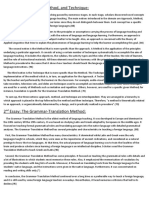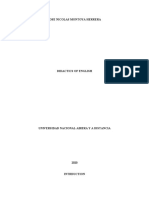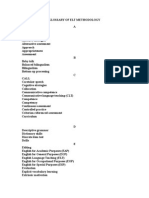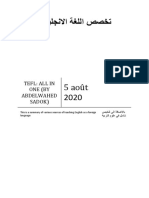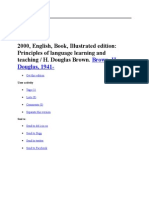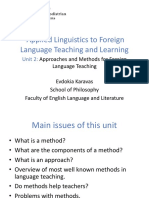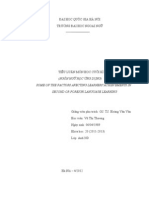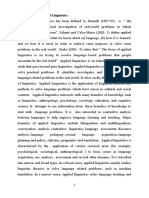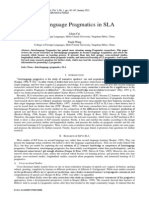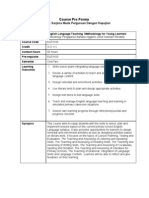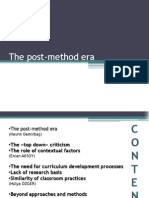0 ratings0% found this document useful (0 votes)
305 views17 pagesApproaches and Methods in Language Teaching - Chapter 20
Uploaded by
Ana CarolinaCopyright
© © All Rights Reserved
We take content rights seriously. If you suspect this is your content, claim it here.
Available Formats
Download as PDF or read online on Scribd
0 ratings0% found this document useful (0 votes)
305 views17 pagesApproaches and Methods in Language Teaching - Chapter 20
Uploaded by
Ana CarolinaCopyright
© © All Rights Reserved
We take content rights seriously. If you suspect this is your content, claim it here.
Available Formats
Download as PDF or read online on Scribd
You are on page 1/ 17
20 Teachers, approaches, and methods
Introduction
We have seen throughout this book that approaches and methods reflect particular
assumptions and beliefs about how learners should learn - assumptions that may need to
be reviewed based on the roles of autonomous learning, learning strategies, learning style
Preferences, and technology-mediated learning. Approaches and methods also prescribe
how teachers should teach. They reflect assumptions about the nature of good teaching, the
Practices and techniques teachers should make use of, the teacher's role in the classroom,
the kinds of language and resources they should use, and the kinds of grouping arrange-
ments and interactions that should occur in their classrooms. When new approaches or
methods are introduced, they are promoted as reflecting sound theory and principles and
as being the best solution to the language teaching problem. They are often based on the
assumption that the processes of second language learning are fully understood. Many
of the books written by method gurus are full of claims and assertions about how people
learn languages, few of which are based on second language acquisition research or have
been empirically tested. Researchers who study language learning are themselves usu-
ally reluctant to dispense prescriptions for teaching based on the results of their research,
because they know that current knowledge is tentative, partial, and changing. As Atkinson.
(zou: xi) comments: “It is increasingly apparent ... that SLA is an extremely complex and
multifaceted phenomenon. Exactly for this reason, it now appears that no single theoretical
perspective will allow us to understand SLA adequately”
Much of SLA research does not support the often simplistic theories and Prescriptions
found in the literature supporting some approaches and methods. For example, in making
their case for CLIL, Coyle, Hood, and Marsh (2010: 153-4) comment:
CLIL has a significant contribution to make not only to providing leamers of all ages
with motivating experiences which are appropriate for knowledge creation and shar-
ing, but also, fundamentally, to cultivating the “cosmopolitan identity” ... where learn-
ing and using languages for different purposes generates tolerance, curiosity and
responsibility as global citizens.
Commenting on this grandiose claim, Paran (2013: 140) observes: “Quite apart from the
difficulty of any teaching programme to achieve this, it is not clear why CLIL can do this
better than any other teaching, unless we accept that CLIL is ‘better’ than other language
teaching, which is where the circularity of the argument comes in”
346
20 Teachers, SPProBches, and methods 47
Atany given time, some approq
acticed, While others may preaches ang
Method,
AVE attracted a
re given wide Support at Io
a
become widel
uch m,
cal, national, ie ore limited 4,
qsthe framework for the national curricula,
interest. Some proposals
ra etational levels when they are adopted
Sr oe °F Supported by educ
ee tie coe wlth ot academics, and decision-m, i nine eedicine
ch ws the cn conte poise Language Teaching (Chapter s) and hae also
been tru 2 (Chapter cui ‘Ask-Based Language Teaching (Chapter 9), ‘Text-Based
Instruction f (Chapter 6), and the Common European Framework of
' From the descriptions Biven in thi
approaches and methods are unlikely to be wi, difficult to
understand and use, lack Clear practical application, Tequire special training, are not
readily compatible with local traditions and Practices,
teachers’ practices and beliefs
and necessitate major changes in
However, approaches and methods Benerally offer Very different proposals for how
to teach. This sometimes Creates a dilemma for teacher educators, teachers, Program
coordinators, and decision-makers in ministries of education: on what basis should
an approach or method be Selected? And what are the alternatives? In this chapter we
will consider three options that are available to teacher-educators, teachers, and other
decision-makers and consider the assumptions and implications of
are (a) to match teaching to the method; (b) to adapt the method to
develop a personal approach or method,
ly accepted and
Match your teaching to the method
An assumption of all of ¢
chosen approaches or metl
and methods,
the instructional designs discussed in this book is that the
thods work, that they are more effective than o'
ther approaches
any different situations,
~ aS one set of theories, ideas, ced by another and
Presumably more appropriate and up-to-date set. Presented with @ new approach or
method such as Task-Based Language Teaching, CLIL, or Text-Based Instruction, the
teachers’ task is to study the method and its Principles and then apply the procedures
it recommends to their own teaching. To be able to do this, teachers need to acquire
new beliefs and Practices,
and practices is tepla
New beliefs
Before changing his or her Practices, the teacher needs to acquire a new oe base 7
Some of which may run contrary to the teacher's own beliefs and bear (Borg
2006). Based on the assumption that practices will not change wales the a hers
beliefs also change, those promoting the adoption of new approaches and met! 1ods face
348 _ The teaching and learning environment _
the task of bringing about changes in a teacher's beliefs. This is normally addressed in
@ number of ways:
* By persuasion: philosophical or ideological reasons may be used to support the new beliefs,
such as arguments in favour of the value of learner autonomy or collaborative learning,
* By citing theory and research that supports the new method: this has characterized pro-
motion of the Natural Approach and Task-Based Language Teaching as was also true of
earlier methods such as Audiolingualism.
By citing evidence of successful learning outcomes: this is often seen in discussions of
CLIL and Content-Based Instruction.
By appeals to authorities: support from credible experts and authorities can also be
Persuasive, such as recommendations from leading academics, “gurus,” educational
authorities and organizations, and so on. Support of this kind was crucial to the accept-
ance of Communicative Language Teaching in the 1970s (Richards 1984).
‘Much of the focus of graduate courses in language teaching is directed toward reshaping
teachers’ knowledge and beliefs through the study of some of the vast body of research and
theorizing on second language learning and teaching. However, teachers’ beliefs are often
resistant to change. Clark and Peterson (1986) noted the following:
+ The most resilient or “core” teachers’ beliefs are formed on the basis of teachers’ own
schooling as young students while observing teachers who taught them. Subsequent
teacher education appears not to disturb these early beliefs, not least, perhaps, because
it rarely addresses them.
© If teachers actually try out a particular innovation that does not initially conform to their
prior beliefs or principles and the innovation proves helpful or successful, then accommo-
dation of an alternative belief or principle is more plausible than in any other circumstance.
¢ For the novice teacher, classroom experience and day-to-day interaction with colleagues
has the potential to influence particular relationships among beliefs and principles and,
over time, to consolidate the individual's permutation of them. Nevertheless, it seems
that greater experience does not lead to greater adaptability in our beliefs and, thereby,
the abandonment of strongly held pedagogical principles. Quite the contrary, in fact.
‘The more experience we have, the more reliant on our “core” principles we become and
the less conscious we are of being so.
New practices
In addition to acquiring a new set of beliefs and understandings, teachers adopting a new
method also need to acquire a new set of practical skills. They may need to become familiar
with a new set of procedures for teaching lessons, to learn to use different kinds of teach-
ing materials and resources, or to change the kinds of interactions they have with learners.
A shift from teacher-directed teaching to the use of group-based activities, for example,
requires not only a change in the teacher’s mind set but the learning of new routines for
organizing a lesson. Practices of this kind are often the focus of training sessions, micro-
teaching, workshops or demonstrations designed to show teachers how to teach a lesson
johnson 2009). When teachers have di
training perspective the issue is either 4
how teachers are taught about the method
sag end. Did the teacher
ing (ne of sta use the correct procedures? Did th
sequence of stages recommended when teacher follow the correct
fficulty in applyi
‘0 imp
),
" ing the method correctly, from a
‘Ove the system of transmission and delivery
oF to find out what went wrong at the receiv-
musing the method? Accounts by teachers using
thegwards and Wills (2005.3) coset Ovice teachers into the method. For example,
S ar i
Donald Freeman, endorsing the book, cited in the book eo ers implement TBLT.
the new method can also be used to ind,
dopting task-based teach
hie teaching ... the contributors to this collection write about their
The metaphor of a “shared grammar’ is interesting since it Suggests how the method is con-
ceived as a system of rules that teachers need to internalize and apply in their own practice.
Criticisms of matching teaching to the method
But a number of objections can be made to the Practice of presenting teachers with the
‘pre-packaged expert-designed” teaching product that methods often seem to Tepresent
and inviting teachers to adopt it as the source of their classroom teaching. One criticism is
that methods are suitable for only inexperienced teachers. Another is that they restrict the
teacher's contribution to teaching.
Methods are only suitable for novices
It could be argued that presenting teachers with a pre-packaged method may be appropri-
ate for novice teachers but not for more experienced teachers. Many experienced teachers
typically began their professional training with a certificate-level training course in which
they were taught to teach according to the methodology presented in their course - be it
the PPP lesson model of the older RSA Certificate or an integrated-skills “communicative”
lesson format found in more recent training programs (Richards, Ho, and Giblin 1996). As
they gain experience, many teachers report that they no longer use the methods they were
trained to use but adapt a much more flexible approach to methodology (Richards, Gallo,
and Renandya 2001). For entry-level teachers with little professional or practical knowledge,
the use of methods in programs like these is intended to provide trainees with a level of
security, Methods, it could be argued, solve many of the problems beginning teachers have
to struggle with because many of the basic decisions about what to teach and how to teach
it have already been made for them. Therefore, for novice teachers, methods are probably
350. The teaching and learning environment
necessary. Moreover, method enthusiasts create together a professional community with a
common purpose, ideology, and vernacular, This provides adherents with a cohort group
of like-minded teachers with whom they can share ideas and experiences. Like the “PPP
prescription of Presentation, Practice, and Production (Chapter 3), a method offers to the
novice teacher the reassurance of a detailed set of sequential steps to follow in the class-
room, Nevertheless, in recent years, even for novice teachers, schools are somewhat less
rigid than they had been in the past in prescribing a method and teaching techniques.
In the case of experienced teachers, methods can restrict the teacher's options and
choices and discourage the teacher from developing a personal teaching approach. They
can limit creativity and encourage teachers to focus on the method rather than on the
learners. Therefore, the practice of encouraging experienced teachers to match their teach-
ing to a method has come under significant criticism.
Methods presents a deficit view of teaching
A “follow the method” strategy has also been described as reflecting a deficit view of teach-
ing, one that suggests that teachers are generally deficient in their understanding of teach-
ing and that this problem can be rectified through the use of a method that was designed by
experts. Teachers have to accept on faith the claims or theory underlying the method and
apply them to their own practice. They are therefore seen as involved in the application of
other people’ theories and principles, rather than engaged in developing theories and prin-
ciples of their own. The roles of teachers and learners, as well as the type of activities and
teaching techniques to be used in the classroom, are generally prescribed and not open to
negotiation. Absent from the traditional view of methods, described above, is a concept of
learner-centeredness and teacher creativity: an acknowledgment that learners bring differ-
ent learning styles and preferences to the learning process, that they should be consulted in
the process of developing a teaching program, and that teaching methods must be flexible
and adaptive to learners’ needs and interests and reflect the teacher's thinking.
Adapt the method to your teaching context
‘A more flexible way of considering approaches and methods is to see them as a resource
that can be tailored to the teacher’s needs. This view of the relationship between teachers
and methods assigns a greater role to teacher creativity and individuality and positions a
method in a supporting rather than a controlling role. The method is viewed as providing
a core set of principles and procedures that can be adapted and modified according to the
teacher's teaching context. Questions teachers might ask from this Perspective, ones where
the answers may require some creativity, would include:
How can I use a communicative approach in a class of 7o students?
How can I use Cooperative Language Learning in an exam-driven curriculum?
What principles from the Silent Way can I use in teaching speaking?
How can I adapt Total Physical Response to use in a business English course?
How can Task-Based Language Teaching be used with young learners?
er
is view of methods, th 7
ph eis Vi e ways
apt methods is valued, ay ich teach ,
and 000F the overall teaching vowel the use ofa ern
ve fiw personalized interpretations of gone HOO teachers we 24 OF APPFOACh might
Me acbeve their individual uses of g ors TAcher development gen eeTeBe 10 develop
ef ethod. may on hy
mhe Lesson Study Approach apts focus on how teach-
th er in a GTOUP and co: plan vais and Tsuchida oe ae this can take place is
dy and that reflects their share ats Suse on a para oo Teachers work
of setpool has adopted. During ares POOP of teahing at BSE OF content or nit
} During this and the method
pao on student learning and the at they engage i sted that yey oe
wren developed, one member of
in extended conversations whi
lopment of speci ions while
é : the team voluntecns Pesie outcomes. Once the plan has
(Sometimes outsiders are also invited tg
lunteers t ‘i
siders ObSerVe_) Af ach while the others observe.
findings in 2 colloquium or panel discussi,
+ the lesson, the group di
: the group discuss theit
focus on their rationale for how they plan ea at teachers who planned the les.
re Planned the lesson and their evaluation of how
then a dito antiNg Broup then re-convene
‘he eye culminates inthe team publishing a report that inca Le ee
student behavior, teacher reflections, and e sane prince aaron
then made available to others,
lary of the group discussions. These are
» localize, personalize,
‘When teachers adapt methods to their local contexts of
a se, the adaptations they make
will reflect both the teacher's personal understandings, beliefs and ae also
adjustments due to local factors such as the class size, classroor
level, age, backgrounds, needs, learning styles, goals, and
1m resources, learners’ proficiency
; 80 on. The teacher's role is to align
the method to their classroom and school context. In this
‘way there is a better fit between the
method and the contexts of its use - the culture of learning in which a teachers works. Jin and
Cortazzi (2011: 571) describe this in relation to the learning in Chinese classrooms:
“Cultures of learning” describes taken-for-granted frameworks of expectations, atti-
tudes, values and beliefs about successful learning and teaching, about learning and
using different language skills in classrooms, and about how interaction should be
accomplished. For students, this includes ways of preparing for English exams, setf-
study practice and classwork. It includes giving great Importance to the teacher, ‘to the
book, to models and explanations, to mimicking and memorizing, to practising an
performing ... It also includes deeper values of the importance of learning and study;
their respect for teachers for their knowledge, cultivation of learning and morality; their
awareness of teachers’ guidance, care, concern, devotion and sacrifice (cognitive,
social and affective dimensions). It includes a deep belief = ae a contnuous
effort leads to success (not just having talent), that re is possible,
ficulties and hardships can be endured and surmountee,
trained
‘Thus, an important task for the teacher is to adjust the methods he or she has been traine
ae d.
to use to the culture of learning in which they are uset
Develop a personal approach or method
Another way of characterizing the relationship between teachers and methods is to shift the focus
from methods to the teacher. This can be seen as a change in agency - from methods that change
teachers, to teachers that are engaged in the process of developing their own teaching methods
and approaches. This changed perspective on methods has been characterized as “post-method”
(Kumaravadivelu 1994, 2003). The following are characteristics of a post-method philosophy.
Using principled eclecticism
In language teaching the blending of methods into the teacher's own method has long
been a recommendation of methodologists. Jin and Cortazzi drawing on Brown, Larsen-
Freeman, and others offer the following summary (20n: 561):
This approach would be flexible, based on an analysis of local circumstances and
needs, with a theoretical rationale and coherent principles and a philosophy of explo-
ration and reflection. Interestingly, there is some tradition of being eclectic in this way
among prestigious language teachers. It was advocated by Rivers, who cites Henry
Sweet (1889): “A good method must, before all be comprehensive and eclectic. It
must be based on a thorough knowledge of the science of language” and general
Principles rather than the “one absolutely invariable method” and Harold Palmer's
“multiple line of approach”, which “embodies the eclectic principle”; “we use each and
every method, process, exercise, drill, or device ... to select judiciously and without
Prejudice all that is likely to help us in our work. Conversely, inflexibility is likely to
become dysfunctional” And “Any method ceases to be efficient when it is applied
inflexibly, according to set procedures, in every situation” (Rivers, 1981, 27).
Ina survey of teachers’ view of methods in Turkey, Griffiths (2012: 473) reports:
Although the need to be aware of a variety of methods was acknowledged, several
respondents also stressed the need to be able to choose methods appropriate to the
needs of their students. Overall, the preference of the teachers in this study seemed to be
{or an eclectic approach to methodology, which leaves the teacher free to choose from a
Variety of methods in order to help their students achieve success in language learing.
However, with an eclectic approach of the kind referred to here the principles the
teacher draws on are derived from external sources - from the methods the teacher is
familiar with. The teacher's task is to review, sele » and blend different Principles and
Practices. For example, a teacher might ask the following:
Are there aspects of Audiolingualism that are compatible with Communicative
Language Teaching?
How can Grammar-Translation be used in a text-based approach?
How can I combine a task-based and a text-based approach?
Can cooperative learning and competency-based approaches be used together?
a rf
qnparing form-based and meanin
mg eclecticism: “itis not ny
ron. Rather,
» Lightbown and Spada (2006: 180)
180) rec
— form-based and meaning-based
using personal principles and practical ‘between these two orientations”
st-method approach i knowledge
sha Zing philosophy, ane 1 when teachers are encouraged to develop
; le,
jedge base that is sometimes re farted oe instructional strategies, This leads to
think it's
important to '
ive aa ' Bie Positive, as a personality, | think the teacher has to be a
posit ; You have to show a tremendous amount of patience. And |
think if you have @ good attitude, you can project this to the students and hopefully
establish a relaxed atmosphere in your classroom, so that the students won't dread to.
come to class, but have a good class. | feel that it’s important to have a lesson plan
of some sort ... because you need to know what you want to teach, and how you
are going to go from the beginning to the end. And also taking into consideration the
students, what their ability is, what their background is and so on. | have been in situ-
ations where | did not understand what was being taught, or what was being said, and
how frustrating it is, and so when | approach it, | say, “How can | make it the easiest
way for them to understand what they need to learn?”
‘Teacher training, teaching experience, as well as the teacher's personal philosophy
and understanding serve as a source of principles and practical knowledge that can be
applied across different situations as well as in specific situations, such as when teaching
large classes, teaching young learners or adults, teaching mixed-ability classes, or teaching
specific content such as grammar or reading skills. "The following are examples of principles
that are part of teachers’ PPK (Bailey 1996; Richards 1996):
¢ Engage all learners in the lesson.
¢ Make learners, and not the teacher, the focus of the lesson.
* Provide maximum opportunities for student participation.
Develop learner responsibility.
¢ Be tolerant of learners’ mistakes.
Develop learners’ confidence.
Teach learning strategies.
Respond to learners’ difficulties and build on them.
Use a maximum amount of student-to-student activities.
354 The teaching and learning environment
© Promote cooperation among learners.
© Practice both accuracy and fluency.
Address learners’ needs and interests.
Make learning fun.
‘Teachers refer to these principles and core beliefs at different stages of teaching - prior to teach-
ing, during the planning phase ofa lesson, during the lesson itself (i.e., interactive or ‘on-the-spot
unplanned decisions), and after teaching a lesson when they reflect on what happened during
the lesson. Golombek (2009: 157) cites research by ‘Tsang on how teachers access PPK:
‘Tsang (2004) investigated how the PPK of three pre-service “English as an addi-
tional language” teachers of ESL in Hong Kong affected their interactive decision
making. The results showed that the teachers referred to their PPK in describing
their interactive decision making in the classroom in approximately half of the
instances. On the other hand, teachers more frequently called upon their PPK while
describing their post-active decision making, enabling changes to be made in future
lesson plans and future on-line teaching, and new understandings of their teaching
philosophies.
It is perhaps due to the influence of teachers’ core beliefs and PPK that teachers
transform the methods they may have been trained to use. Research on teachers’ use of
methods has often found that at the level of classroom practices, methods are often more
similar than different. Swaffar, Arens, and Morgan (1982: 25) commented: “One consist-
ent problem is whether or not teachers involved in presenting materials created for a
particular method are actually reflecting the underlying philosophies of these methods in
their classroom practices” Swaffar and her colleagues studied how teachers using differ-
ent methods implemented them in the classroom and found that many of the distinctions
used to contrast methods, particularly those based on classroom activities, did not exist
in actual practice:
Methodological labels assigned to teaching activities are, in themselves, not informa-
tive, because they refer to a pool of classroom practices which are used uniformly. The
differences among major methodologies are to be found in the ordered hierarchy, the
priorities assigned to tasks.
(Swaffar et al. 1982: 31)
Brown (1997: 3) makes a similar point:
Generally, methods are quite distinctive at the early, beginning stages of a language
course, and rather indistinguishable from each other at a later stage. In the first few
days of a Community Language Learning class, for example, the students witness
a unique set of experiences in their small circles of translated language whispered
in their ears. But within a matter of weeks, such classrooms can look like any other
learner-centered curriculum.
20 Teachers, approaches, and methods 355
t video samples of differ students increases. It is, is
ie an early lesson) of a ae and methods yplaly erties ete lenda
tions” with intermediate or fidvanced econ ‘There are no convincing video “demonstra-
jevel there is nothing distinctive to doom because, as Brown points out, at that
Theorization of practice
‘A related dimension of teacher learnin
pased teaching can be seen as an a
ceptualizing teacher |
the development of
1g involves the theorization of practice. While method-
caming iste ee OF theory to practice, a different way of con-
a theoretical oye 3S involving the theorization of practice, that i
inderstanding of teaching from experiences of teaching.
of
7 ine ooo rates 8 teacher's negotiation of multiple sources of knowledge
liefs and values, pedagogical and content knowledge, knowl-
edge of children, and the expectations of the school culture where he or she works
ce eee decisions. It is continually tests and modified as the teacher
‘aintain coherence between what she or he thinks and what she or he
practices.
(Dubetz 2005: 235)
‘Teachers begin their experience of teaching with varying levels of theoretical as well as
practical knowledge, and their familiarity with one or more approach or method is part of
this knowledge base. Over time, however, the teacher's knowledge and beliefs change as a
result of new understandings of themselves and their learners, their understanding of their
classroom context and the curriculum, as well as their acquisition of new kinds of profes-
sional knowledge obtained from reading, from the Internet, from workshops, and from
colleagues as well as other sources. The classroom thus becomes a site for learning and
for the development of deeper and more extensive theoretical understandings of teaching,
‘These may lead the teacher to develop new teaching strategies. As they try them out and
review their impact on learning, they become part of the teacher's knowledge base. The
teacher now has a more fully developed schemata to support his or her teaching through
the theorization of practice in this way.
Options for teacher education
Teacher education courses reflect a variety of different positions concerning the role they
attribute to the study of teaching approaches and methods. Some of these differences reflect
whether the course has a “teacher-training” approach and is intended for pre-service teach-
ers or a “teacher-development” perspective and is aimed at experienced teachers complet-
ing more advanced courses, perhaps at the MA level. The contexts where the trainees will
work after completing a course also affect the status of method analysis in the curriculum.
356 The teaching and learning environment.
Some courses contain international students who will work in very different teaching
contexts from those courses after they complete their program, often in situations where a
Particular teaching approach is recommended by the ministry of education. Some courses
may be targeted at teachers who will work within a particular institution (such as a pri-
vate institute) or in a school system that has a mandated curriculum and an established
approach or method in use. Other teacher education programs may be for experienced
teachers who have well-developed understandings and practices and are interested in how
these can be better understood or evaluated in the light of current theory and research. A
number of options are available as outlined below.
Familiarity with one established method
One option for teacher education programs is immersing teachers in a particular approach
or method (such as Communicative Language Teaching or Text-Based Instruction). This
strategy is more typical with entry-level courses for new teachers, as mentioned earlier.
Training is designed to develop teachers who are skilled users of a particular method.
Assessment may be based on how well the teacher can use the principles and procedures
ofa method such as CLT. For example, Richards et al. (1996) describe a study of five trainee
teachers completing what was then called the UCLES/RSA Certificate in TEFLA - a short
introductory teacher-training program based on a blend of CLT and the use of a PPP
lesson format. During the course the trainees study the required teaching principles and
procedures, apply them in lessons during teaching practice, and receive feedback on their
performance by the trainer and other trainees. This strategy is also common in contexts
where a curriculum reform or change requires teachers to familiarize themselves with a
new approach or method, such as when Singapore adopted TBI as the basis for a national
English language curriculum. Courses and workshops are provided to familiarize teachers
with the method.
However, teachers and teachers in training need to be able to use approaches and
methods flexibly and creatively, based on their own judgment and experience. In the pro-
cess, they should be encouraged to transform and adapt the methods they use to make them
their own. Training in the techniques and procedures ofa specific method is probably essen-
tial for novice teachers entering teaching, because it provides them with the confidence they
will need to face learners and with techniques and strategies for presenting lessons. In the
carly stages, teaching is largely a matter of applying procedures and techniques developed
by others. An approach or a predetermined method, with its associated activities, principles,
and techniques, may be a useful starting point for an inexperienced teacher, but it should
be seen only as that. As the teacher gains experience and knowledge, he or she will begin to
develop an individual approach or personal method of teaching, one that draws on an estab-
lished approach or method but that also uniquely reflects the teacher's individual beliefs,
values, principles, and experiences. This may not lead to abandonment of the approach or
method the teacher started out using but to a modification of it as the teacher adds to and
adjusts the approach or method to the realities of the classroom,
iduate
Programs desi
complet signed fo
in myers to teach flexibly ang aes, the course, The forests who may teach
i The focus is typi
' ‘i ively, focus is t
ws ding to the teaching contexts they eae on relevant adhe, ieee on prepar-
rograms consist of a survey of femselves in, The typical ind procedures
Current and pas al “methods” courses
Video or throu,
ince approach Way to suy :
Ce on a belts noes He aed eel in the
ofr profession, we 8 ye lee it will continue to be useful for te — in the development
ers t0 ben uy iE with the major teaching approaches aa lers and student teach-
.d and foreign language teaching. Mainstream methods proposed for
jarge amount of collective experience at approaches and meth
na jods draw on
se ead meds tee ete en which much can be learned,
we rs ly Studied and selectively mastered in
Jearn how to use different approaches and
ea methods and understand when they might
derstand some of the issues and : :
. aa saath inc’ controversies that characterize the history of lan-
« participate in language learning experiences based on different
asa basis for reflection and comparison; int approaches and methods
« beaware of the rich set of activity resources available to the imaginative teacher;
«appreciate how theory and practice can be linked from a variety of different perspectives
A post-methods approach
‘This strategy is also favored in some graduate programs or in courses for experienced
teachers. The focus is on developing a framework of theory and principles that can be
used to support an individual and personal teaching approach. Methods are looked at
critically in order to detect the assumptions they are based on and the interests they are
seen to represent. Alternatively, the study of methods may have no role in the program
at all. Sometimes the stance of Critical Language Pedagogy (CLP), a philosophy that
eschews reliance on methods, underlies this approach. As described by Allwright and
Hanks (2009: 54):
CLP questioned why the world of language teaching was so full of competing meth-
ods, and speculated about whose interests this served ... The conclusion was that the
dominant interests were commercial and political (introducing the controversial notion
of “linguistic imperialism’) rather than educational.
358 The teaching and learning environment ~
‘This theme has been elaborated by Kumaravadivelu (2012: 18-19).
These Center-based [or Western] methods {see Chapter 1] (such a auccingua
communicative) have been aptly characterized as product of oleae lodge”
(Pennycook 1989) ... That is, these methods highlighted and promoted nate tei
er’s language competence, learning styles, communication patterns, scores ;
maxims, cultural beliefs, and even accent as the norm ...These assumpti ve since
come under severe strain leading to calls for an alternative to the concept of method.
This alternative to the study of approaches and methods, in a CLP approach, a ne
ing teachers engage in critical reflection, exploratory practice, classroom research ss
related procedures, They are encouraged to develop a healthy skepticism icOncEERINE. the
claims of methods, and they take part in activities that help them identify and review the
basis of their own knowledge, beliefs, and practice and to develop a personal methodologi-
cal framework that is relevant to their own teaching context (Allwright and Hanks 2009).
Conclusion
In this chapter, we have considered three major ways in which teachers can approach the
selection of an approach or method. They may consider matching their teaching to the
method, adapting a method to their teaching context, or developing a personal approach
or method. Each of these philosophies offers various options for teacher education
programs. The relationship between approaches and methods and teachers is complex,
simply because methods do not teach: teachers do, The extent to which the assumptions
and principles underlying different method philosophies shape the thinking, decision-
making, and practices teachers make use of in their teaching depends on a number of
factors, including the teaching context, the teacher's theoretical and practical knowledge
base, the teacher's experience, and his or her core principles and beliefs. Although within
the language teaching profession the nature of approaches and methods has had a central
place in accounting for trends and practices in language teaching, at the level of teachers’
classroom practices teaching is a much more complex and dynamic process than methods
often represent. Most teacher-training programs are designed on the assumption that
knowledge of principles and practices of one or methods provides teachers with a useful
set of techniques and strategies that they can use in their classrooms or adapt for their
own needs. But there is sometimes the underlying assumption that good teaching cannot
be achieved without the structure and guidance that methods are believed to provide,
However, the adoption of new practices by teachers is problematic - on both practical and
ideological grounds ~ since it undervalues the contributions teachers make to teaching.
If the study of approaches and methods is included in a teacher education Program, an
appropriate focus for the inclusion of such study is needed, one in which these approaches
and methods are presented not as Prescriptions for best practice but rather as a source
for reflective review of the teacher's own core principles, theoretical under: i:
» standi id
personal practical knowledge, —
You might also like
- Language Teaching Models: (PPP, Esa, TBLT)No ratings yetLanguage Teaching Models: (PPP, Esa, TBLT)23 pages
- The Impact of Integrating English in Algerian Primary SchoolsNo ratings yetThe Impact of Integrating English in Algerian Primary Schools16 pages
- Techniques and Principles in Language TeNo ratings yetTechniques and Principles in Language Te45 pages
- An Overview of Second Language Teaching Methods and ApproachesNo ratings yetAn Overview of Second Language Teaching Methods and Approaches10 pages
- Approaches and Methods in Language Teaching - Chapter 19No ratings yetApproaches and Methods in Language Teaching - Chapter 1915 pages
- Assignment - 2 Methods of Language TeachingNo ratings yetAssignment - 2 Methods of Language Teaching6 pages
- Mod - 2 - 2.1 The Structural View of Language100% (1)Mod - 2 - 2.1 The Structural View of Language2 pages
- The TESOL Encyclopedia of English Language Teaching - 2018 - Ali - Community Language LearningNo ratings yetThe TESOL Encyclopedia of English Language Teaching - 2018 - Ali - Community Language Learning5 pages
- Historical Timeline of The Main Language Teaching Methods-Comprimido100% (1)Historical Timeline of The Main Language Teaching Methods-Comprimido2 pages
- Student-Centred and Teacher-Centred MethodsNo ratings yetStudent-Centred and Teacher-Centred Methods9 pages
- Inductive and Deductive Methods of Teaching GrammarNo ratings yetInductive and Deductive Methods of Teaching Grammar4 pages
- Translation As A Learning Tool in English For Spec100% (1)Translation As A Learning Tool in English For Spec9 pages
- Cognitive Academic Language Learning Approach: CALLA's Basic PremisesNo ratings yetCognitive Academic Language Learning Approach: CALLA's Basic Premises2 pages
- Literature Review: 2.2.1 Definition of Speaking SkillNo ratings yetLiterature Review: 2.2.1 Definition of Speaking Skill9 pages
- 2000, English, Book, Illustrated Edition: Principles of Language Learning and Teaching / H. Douglas BrownNo ratings yet2000, English, Book, Illustrated Edition: Principles of Language Learning and Teaching / H. Douglas Brown5 pages
- Applied Linguistics To Foreign Language Teaching and LearningNo ratings yetApplied Linguistics To Foreign Language Teaching and Learning61 pages
- Difficulties and Strategies in Listening ComprehensionNo ratings yetDifficulties and Strategies in Listening Comprehension14 pages
- Introduction To Guidance and Counseling After Having Read The Course The Students Shall Be Able To100% (1)Introduction To Guidance and Counseling After Having Read The Course The Students Shall Be Able To3 pages
- Approaches and Methods of Language Teaching (241119) Handnote Exam-2023No ratings yetApproaches and Methods of Language Teaching (241119) Handnote Exam-202373 pages
- A Comparison Between Deductive and Inductive Appro100% (1)A Comparison Between Deductive and Inductive Appro13 pages
- ELE3104 English Language Teaching Methodology For Young LearnersNo ratings yetELE3104 English Language Teaching Methodology For Young Learners8 pages
- Topic 4 - Methods, Techniques and Post Methods - VTP3 2024No ratings yetTopic 4 - Methods, Techniques and Post Methods - VTP3 202435 pages
- Yesterday You Were Spotted Doing Something Really Odd Explain Yourself!!!No ratings yetYesterday You Were Spotted Doing Something Really Odd Explain Yourself!!!1 page










